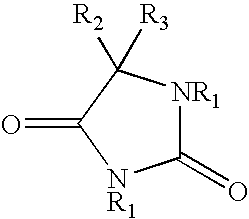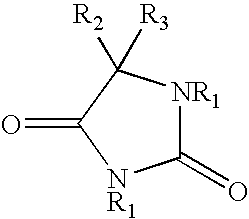Synergistic composition and method for inhibiting growth of microorganisms
a technology of microbial growth and composition, applied in the direction of biocide, water/sewage treatment by oxidation, water/sewage treatment by substance addition, etc., can solve the problems of affecting the efficacy of industrial processes, and requiring expensive microbial control programs for manufacturers
- Summary
- Abstract
- Description
- Claims
- Application Information
AI Technical Summary
Benefits of technology
Problems solved by technology
Method used
Image
Examples
example 1
Mill Producing Paper Grades Using Mechanical Pulp in the Furnish
[0032] The furnish used in this mill is composed of about 50% TMP, 25% bleached Kraft pulp, and 25% broke. White water was collected and total bacterial counts were determined in samples with and without the addition of DMH stabilized chlorine (1:1 molar ratio of DMH to “Cl2) and / or PAA, after 50 minutes of contact time. The results are summarized in the table below.
Biocide (PAA: ppm product;DMH stabilized chlorine: ppm Cl2)Total bacterial countsControl (no biocide added)1.3 × 107 PAA-254 × 106PAA-503 × 105PAA-1003 × 103Cl2-1 107Cl2-24 × 106Cl2-43Cl2-2 + PAA-25 104Cl2-2 + PAA-503
This example shows the synergistic relationship obtained with the present invention. Synergy is mathematically demonstrated by the industry accepted method described by Kull et al. (Applied Microbiology (1961), Vol. 9: 538-541. Applied to the current invention it is as follows: [0033] QA=ppm of active peracetic acid alone, which produces an...
example 2
Mill Producing Paper Grades Using Chemical Pulp
[0040] The furnish used on this paper machine is composed of about 60% bleached Kraft pulp, and 40% broke. White water was collected and total bacterial counts were determined in samples with and without the addition of DMH stabilized chlorine (1:1 molar ratio of DMH to “Cl2”), and / or PAA, after 30 minutes of contact time. The results are summarized in the table below.
Biocide (PAA: ppm product;DMH stabilized chlorine: ppm Cl2)Total bacterial countsControl (no biocide added)5.8 × 106PAA-2.55.8 × 106PAA-51.1 × 106PAA-10 5 × 104Cl2-2.52.7 × 104Cl2-5 6 × 102Cl2-2.5 + PAA-2.5 2 × 103
In this example a>3-log reduction in bacterial counts is achieved with:
[0041] Synergistic Composition:
[0042] Composition 1: PAA>10 ppm
[0043] Composition 2: DMH stabilized chlorine (“Cl2”)=5 ppm
[0044] PAA=2.5 ppm+“Cl2”=2.5 ppm
[0045] Qa / QA+Qb / QB=2.5 / >10+2.5 / 5=<0.75
example 3
Very Closed Mill (3 / Ton) Producing Paper Grades Using Chemical Pulp
[0046] The furnish used in this mill is composed of about 75% bleached Kraft pulp, and 25% broke. White water was collected and total bacterial counts were determined in samples with and without the addition of DMH stabilized chlorine (1:1 molar ratio of DMH to “Cl2”), and / or PAA, after 30 minutes of contact time. The results are summarized in the table below.
Biocide (PAA: ppm product;DMH stabilized chlorine: ppm Cl2)Total bacterial countsControl (no biocide added)9 × 106PAA-504.5 × 106 PAA-751.6 × 106 PAA-1003 × 105PAA-150 103PAA-2002Cl2-19 × 106Cl2-29 × 106Cl2-36.3 × 106 Cl2-45.4 × 106 Cl2-1 + PAA-1009 × 104Cl2-1 + PAA-1502
In this example a 2-log reduction in bacterial counts is achieved with:
[0047] Synergistic Composition
[0048] Composition 1: PAA 150 ppm
[0049] Composition 2: DMH stabilized chlorine (“Cl2”)=>4 ppm
[0050] PAA=100 ppm+“Cl2”=1 ppm
[0051] Qa / QA+Qb / QB=100 / 150+1 / >4=0.67+<0.25=<0.92
PUM
 Login to View More
Login to View More Abstract
Description
Claims
Application Information
 Login to View More
Login to View More - R&D
- Intellectual Property
- Life Sciences
- Materials
- Tech Scout
- Unparalleled Data Quality
- Higher Quality Content
- 60% Fewer Hallucinations
Browse by: Latest US Patents, China's latest patents, Technical Efficacy Thesaurus, Application Domain, Technology Topic, Popular Technical Reports.
© 2025 PatSnap. All rights reserved.Legal|Privacy policy|Modern Slavery Act Transparency Statement|Sitemap|About US| Contact US: help@patsnap.com


